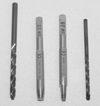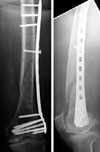Figures and Tables
 | Fig. 2Conical extraction screws and drills for the removal of the stripped head16) (Oh et al, with permission). |
 | Fig. 3Two of the three proximal locking screws seem to be placed through the posterior cortex itself because the plate is placed too posteriorly to the femoral shaft. |
 | Fig. 4Subtle malposition of the plate can result in failure of the locking head screw fixation.
(A) Unusual resistance during the drilling prompted us to check this image, finding the drill bit was passing through the anterior cortex itself.
(B) True lateral image shows just a little bit of plate malposition.
(C) The most distal hole has to be filled with a conventional screw due to the plate malposition.
|
References
1. Bolhofner BR, Carmen B, Clifford P. The results of open reduction and internal fixation of distal femur fractures using a biologic (Indirect) reduction technique. J Orthop Trauma. 1996; 10:372–377.

2. Cole PA, Zlowodzki M, Kregor PJ. Less invasive stabilization system (LISS) for fractures of the proximal tibia: indications, surgical technique and preliminary results of the UMC clinical trial. Injury. 2003; 34:Suppl 1. A16–A29.

3. Cole PA, Zlowodzki M, Kregor PJ. Treatment of proximal tibia fractures using the less invasive stabilization system surgical experience and early clinical results in 77 fractures. J Orthop Trauma. 2004; 18:528–535.

4. Egol KA, Su E, Tejwani NC, Sims SH, Kummer F, Koval KJ. Treatment of complex tibial plateau fractures using the less invasive stabilization system plate: clinical experience and a laboratory comparison with double plating. J Trauma. 2004; 57:340–346.

5. Fankhauser F, Boldin C, Schippinger G, Haunschmid C, Szyszkowitz R. A new locking plate for unstable fractures of the proximal humerus. Clin Orthop Relat Res. 2005; 430:176–181.

6. Gautier E, Sommer C. Guidelines for the clinical application of the LCP. Injury. 2003; 34:Suppl 1. B63–B76.

7. Georgidis GM, Gove NK, Smith AD, Rodway IP. Removal of the less invasive stabilization system. J Orthop Trauma. 2004; 18:562–564.

8. Hamilton P, Doig S, Williamson O. Technical difficulty of metal removal after LISS plating. Injury. 2004; 35:626–628.

9. Kääb MJ, Frenk A, Schmeling A, Schaser K, Schütz M, Haas NP. Locked internal fixator, sensitivity of screw/plate stability to the correct insertion angle of the screw. J Orthop Trauma. 2004; 18:483–487.
10. Kregor PJ. Distal femur fractures with complex articular involvement: management by articular exposure and submuscular fixation. Orthop Clin North Am. 2002; 33:153–175.
11. Kregor PJ, Stannard J, Zlowodzki M, Cole PA, Alonso J. Distal femoral fracture fixation utilizing the less invasive stabilization system (L.I.S.S.): the technique and early results. Injury. 2001; 32:Suppl 3. SC32–SC47.

12. Kregor PJ, Stannard JA, Zlowodzki M, Cole PA. Treatment of distal femur fractures using the less invasive stabilization system: surgical experience and early clinical results in 103 fractures. J Orthop Trauma. 2004; 18:509–520.

13. Krieg JC. Proximal tibial fractures: current treatment, results, and problems. Injury. 2003; 34:Suppl 1. A2–A10.

14. Naranja RJ Jr, Iannotti JP. Displaced three- and fourpart proximal humerus fractures: evaluation and management. J Am Acad Orthop Surg. 2000; 8:373–382.

15. Oh JK, Oh CW, Roh KJ, Jong CW. Conformity of the LCP-DF (locking compression plate-distal femur) in korean adult femur: a cadaver study. J Korean Fract Soc. 2005; 18:399–340.

16. Oh JK, Oh CW, Jung H, Roh KJ, Kim TH. Stripping of the hexagonal recess in the process of LCP (locking compression plate) removal. J Korean Fract Soc. 2006; 19:283–287.

17. Pattison G, Reynolds J, Hardy J. Salvaging a stripped drive connection when removing screws. Injury. 1999; 30:74–75.

18. Perren SM. Evolution and rational of locked internal fixator technology Introductory remarks. Injury. 2001; 32:Suppl 2. B3–B9.
19. Ricci WM, Rudzki JR, Barrelli J Jr. Treatment of complex proximal tibia fractures with the less invasive skeletal stabilization system. J Orthop Trauma. 2004; 18:521–527.

20. Schandelmaier P, Partenheimer A, Koenemann B, Grün OA, Krettek C. Distal femoral fractures and LISS stabilization. Injury. 2001; 32:suppl 3. SC55–SC63.

21. Schutz M, Müller M, Krettek C, et al. Minimally invasive fracture stabilization of distal femoral fractures with the LISS: a prospective multicenter study Results of a clinical study with special emphasis on difficult cases. Injury. 2001; 32:Suppl 3. SC48–SC54.

22. Schütz M, Müller M, Regazzoni P, et al. Use of the less invasive stabilization system (LISS) in patients with distal femoral (AO33) fractures: a prospective multicenter study. Arch Orthop Trauma Surg. 2005; 125:102–108.

23. Sommer C, Babst R, Muller M, Hanson B. Locking compression plate loosening and plate breakage: a report of four cases. J Orthop Trauma. 2004; 18:571–577.
24. Szyszkowitz R, Seggl W, Schleifer P, Cundy PJ. Proximal humeral fractures: management techniques and expected results. Clin Orthop Relat Res. 1993; 292:13–25.




 PDF
PDF ePub
ePub Citation
Citation Print
Print



 XML Download
XML Download